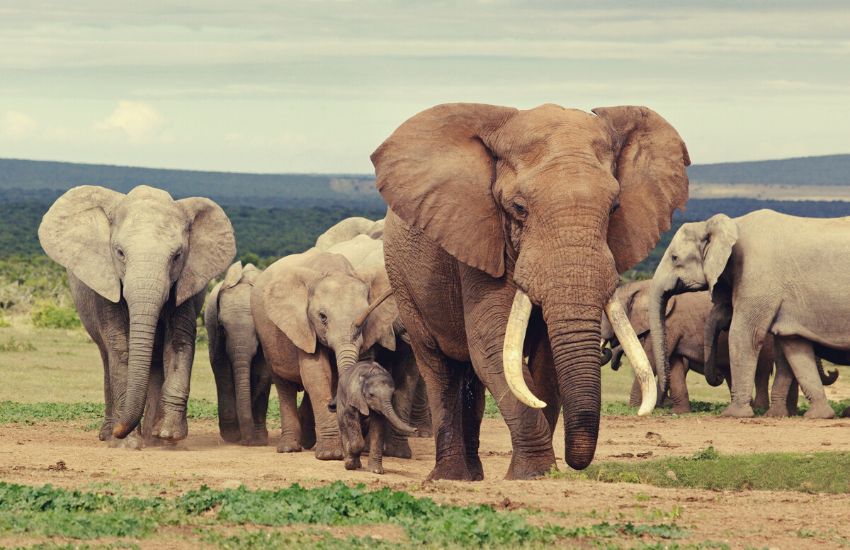shelter pets in need
Each order helps pets in need

You may have seen some interesting photos on the Internet lately. They show elephants and rhinos with tusks and horns dyed pink to prevent the killing of these beautiful animals for their body parts. Is this for real? Well, the short answer is "sort of."
A lot of the images you see of elephants with pink tusks and rhinos with pink horns are digitally altered and not real. But . . . there is an organization called Rhino Rescue Project that is taking some pretty drastic actions in an attempt to save the rhino from poachers.
Poaching has devastating effects on rhino and elephant populations. According to conservation organizations, around 548 rhinos were poached in Africa alone in 2022. Tusks and horns are highly prized on the black market, fueling this illegal trade.
Rhino horns are believed by some cultures to have medicinal properties, though there is no scientific evidence to support these claims. The demand for rhino horns leads to poaching, threatening all rhino species. The Javan, Sumatran, and Black rhinos are critically endangered.
Elephant ivory has been valued for carvings, piano keys, and other items for centuries. However, the ivory trade has led to a massive decline in elephant populations. All species of elephants are threatened.
This act also threatens the livelihood of communities that depend on wildlife tourism. It undermines conservation efforts and funds criminal activity. According to the UN, wildlife crime is the world's fourth-largest criminal enterprise.
In summary, the demand for animal parts has fueled the illegal wildlife trade and threatens the survival of rhinos, elephants, and the communities that depend on them. Conservation and anti-poaching efforts are critical to protecting these endangered species.

As an interconnected global community, illegal wildlife trade affects us all in profound ways.
The loss of elephant and rhino populations disrupts ecosystems' biodiversity and the food chain's natural balance. Their absence poses risks to other plant and animal species that rely on them.
Poaching fuels criminal activity and threatens political and economic stability in African countries where these species live. The illegal wildlife trade is a multi-billion dollar industry linked to drug smuggling, human trafficking, and terrorism.
Wildlife tourism is a primary source of income for many communities in Africa. As elephant and rhino populations decline due to illegal wildlife trade, so does the opportunity for stable employment and livelihoods. Poverty levels rise, and families suffer.
Future generations are deprived of the opportunity to observe these magnificent creatures in their natural habitats. Once a species goes extinct, it is lost forever.
While the challenges are significant, collective action can make a difference. Supporting anti-poaching initiatives, advocating for political will, and reducing consumer demand are all steps toward building a sustainable future for wildlife and humanity.
The Rhino Rescue Project is taking a two-pronged approach to making rhino horn as undesirable to poachers as possible. They are, in fact, infusing a permanent dye (the same type of dye used to stain stolen bank notes) directly into the horns of living rhinos. This dye makes the ivory unusable for ornamental purposes and can also be detected on airport X-ray scanners, even if ground to a fine powder.
Along with the dye, the other step the Rhino Rescue Project is taking is to contaminate the horns of living rhinos with ectoparasiticides (toxins used to kill parasites such as ticks).
Ectoparasiticides are safe for animals but will cause symptoms like nausea, vomiting, and convulsions in humans. Because rhino horn is made into medicine and ingested by people, contaminating the horns makes them unusable. This can deter poachers and help save these animals' lives.
No elephant tusks are being dyed pink at this time, but there is a movement to make that a reality.
Some critics argue that this method is only temporary and that persistent poachers may find ways to remove or mask the dye. However, even if dyeing proves effective for a limited time, it could buy conservationists valuable time to implement longer-term protections for vulnerable species.
Like this article? Check out this in-depth look at factory farming and how it kills the environment!
Your Animal Hearted purchase saves lives! 25% of all proceeds are donated to no-kill animal shelters!

There are several ways you can help combat the illegal wildlife trade and end illegal wildlife trade:
Donate to reputable conservation organizations that work to protect endangered species and combat poaching. Some highly-rated options include the World Wildlife Fund, African Wildlife Foundation, and Save the Rhino International.
Raise awareness about the plight of rhinos, elephants, and other endangered wildlife. Share information on social media, write to government officials or organize fundraising events.
Travel on eco-friendly safaris and tours. Select tour operators that support conservation efforts and community development. Tourism revenue provides jobs for local people and funds the protection of wildlife.
Buy products that don't contain ivory, rhino horn, or other wildlife parts. Avoid purchasing souvenirs made of elephant tusks, rhino horns, turtle shells, or exotic leathers like crocodile skin.
Contact government leaders and demand they take action against wildlife crime and support conservation—petition for stronger laws and enforcement against illegal wildlife trade.
The dye used by Rhino Rescue Project is a specialized formula that permanently stains rhino horns and is non-toxic. Its ingredients are proprietary but believed to be a mixture of indelible dyes and other chemicals that do not harm the rhino. The neon pink dye is pungent smelling and foul-tasting, making the horn visually undesirable and useless for ornamental or medicinal purposes.
Rhinos and elephants are keystone species critical to maintaining balance in their native ecosystems. The loss of these megaherbivores has devastating effects on biodiversity. Their extinction would damage plant communities, harm other wildlife, and disrupt vital ecological processes.
Comments
Leave a comment